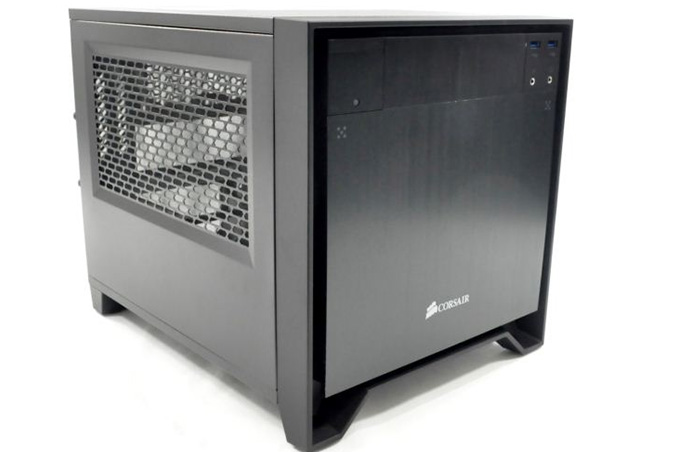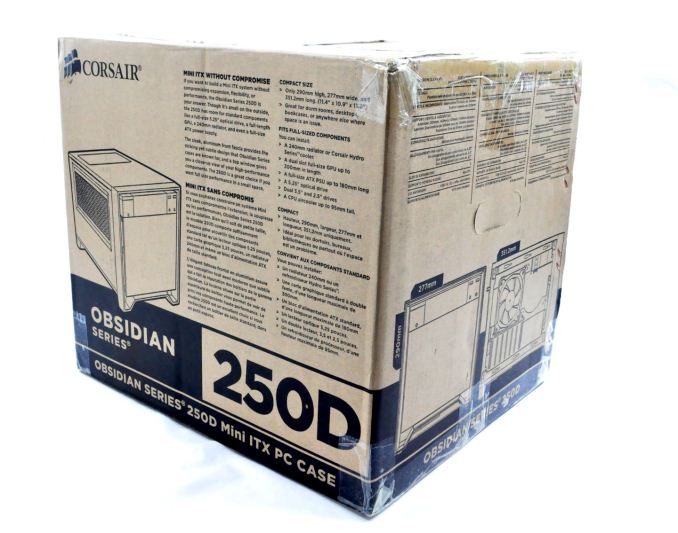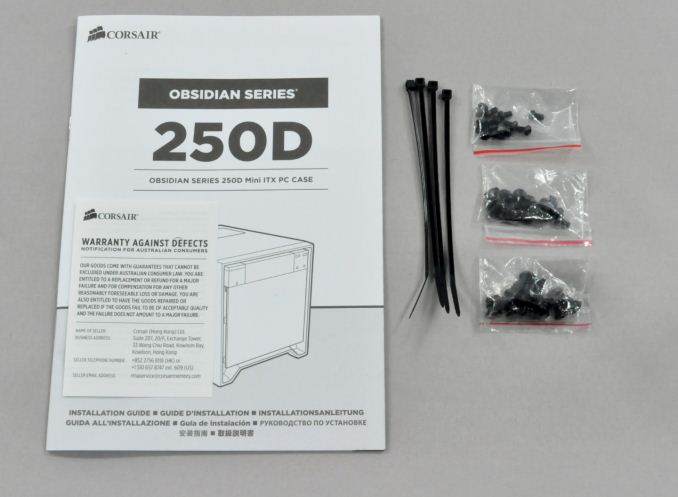Corsair Obsidian 250D Case Review
by E. Fylladitakis on January 21, 2014 12:00 PM EST- Posted in
- Cases/Cooling/PSUs
- Corsair
- Mini ITX
- Case

Ed: As this is his first review, we’d like to quickly introduce E. Fylladitakis. E. is taking over Cases & Cooling coverage as our newest editor, so this is the first of many articles you will see from him over the coming months
Corsair is a very well-known manufacturer among technology enthusiasts, and the company has been a supplier of premium memory modules for decades. During the past several years however, the company has successfully diversified into many segments of the market and today offers numerous products: computer cases, power supply units, air and liquid CPU coolers, solid-state drives, and gaming peripherals can all be found in Corsair's product ranks.
With the recent announcement of the Obsidian 250D, the company chose to start 2014 by joining the Mini ITX case fever, something most other large case designers and manufacturers have done recently. The Obsidian 250D however has not been designed with minimum proportions in mind; despite the Mini ITX format, it can still house very powerful gaming systems and advanced cooling solutions. The specifications of the case can be seen in the following table.
| Corsair Obsidian 250D | ||
| Motherboard Form Factor | Mini-ITX | |
| Drive Bays | External | 1 × 5.25" |
| Internal | 2 ×2.5" 2 × 3.5" | |
| Cooling | Front | 1×200 / 140 mm (140 mm included) |
| Rear | 2×80mm | |
| Top | - | |
| Side | 2 x 120 mm (1 × 120 mm included) | |
| Bottom | - | |
| I/O Port | 2x USB 3.0, 1x Headphone, 1x Mic | |
| Power Supply Size | ATX | |
| Clearances | HSF | ≈145 mm |
| PSU | - | |
| GPU | ≈295 mm | |
| Dimensions | 350 mm ×277 mm ×290 mm(D × W × H) | |
| Weight | ≈5kg | |
| Prominent Features | Aluminum front fascia and thick steel construction Top window for component visibility Thumbscrew backplate removal for PSU and hard drive access Easily removed dust filters on all intakes Simultaneously fit two 3.5”/2.5” drives, two 2.5” drives, one 5.25” drive, a full sized PSU, a 290mm long GPU, and a 240mm radiator Innovative three panel removal for sides and top panel, with thumbscrews Tons of cable routing tie downs for easy cable maintenance Tool free installation of all drives | |
| Price | ≈ 70 EUR / 89.99 USD | |
We received the Obsidian 250D inside a short, simple cardboard box that hints at the cubic shape of the case. Inside the box, we found the case packed between thick Styrofoam slabs and wrapped in a nylon bag, which is more than ample shipping protection for the small, lightweight case.
The bundle of the Obsidian 250D is sparse, with Corsair supplying only the absolutely necessary parts needed to fully assemble a system. We only found a manual, three small bags with black screws and a few black cable ties. At least some more cable ties and perhaps a couple of cable straps would be a nice addition. The bundle may be found in a cardboard box secured into one of the 3.5" trays.












52 Comments
View All Comments
Death666Angel - Wednesday, January 22, 2014 - link
"it can also backfire if the user is far too negligent"You can say that about every case. I've seen enough people coming to forums saying that their 1 year old PC suddenly freezes or has terrible performance or is super loud. Some time late we find out the CPU and/or GPU throttle and it is mostly the case of the the coolers being clogged by dust and debris. In my opinion, it is far easier to see and remove dust from filters than it is from the coolers themselves. So I'd still give this one a better grade than most other cases (note: many Silverstone ones have positive air pressure with filter designs which helps this a lot!).
E.Fyll - Thursday, January 23, 2014 - link
That's true. However, the clearance between the side panel filter and the graphics card fans is but a few mm in this case. Other cases could end up with clogged filters and yet, even if the air could not easily enter/exit the case, there would be room for air circulation. If the side panel filter of the Corsair 250D gets clogged however, I fear that the card will "suffocate", there is just not enough clearance for it to continue sucking air from the side of the card.Hrel - Wednesday, January 22, 2014 - link
Still prefer the Fractal Design Node 304faster - Wednesday, January 22, 2014 - link
Dimensions 350 mm ×277 mm ×290 mm(D × W × H)I could go convert this to inches, but it would be nice if the author did it for me.
Slomo4shO - Wednesday, January 22, 2014 - link
Welcome E! Thank you for the review. I would like to see a write up on the Cooler master Elite 110 as well in the near future :)bobbozzo - Wednesday, January 22, 2014 - link
Try a CPL (polarized, rotatable, filter), and rotate it until the glare (mostly) disappears.And/or move lights around.
Bob
bobbozzo - Wednesday, January 22, 2014 - link
Hi,I'm all for a consistent thermal load for repeatability, etc., but I worry that the noise levels will be misleading.
e.g. imagine 2 cases with similar fans in similar locations and similar airflow (direction, position, and CFM)...
with no component fans, they might sound about the same, but if case A has extensive noise dampening internally, and case B has none, then in the real-world, the components in case A would be harder to hear, resulting in a quieter system.
Perhaps your testing should be expanded to include some noise sources to simulate CPU and VidCard coolers (and maybe liquid cooling pumps).
The PSU fan is another possible source of noise; some cases (e.g. FD Node 304) now have the PSU mounted in the middle, so a noisy PSU might be quieter in such a case.
Thanks!
E.Fyll - Thursday, January 23, 2014 - link
Good thinking bobbozzo,Indeed, a case which has sound insulation will most likely result to lower noise levels than a case which has not (even though that is not always the case). However, I fear that currently I can only assess the noise level of the stock case and still end up with comparable results. You see, the sound pressure level, the position of the sound source, its frequency and several other factors are in play here. You could even use two configurations which generate similar acoustic pressure and yet end up with different results for each of them. Even if I do use some equipment to simulate the sound of a system, the results can vary depending on the configuration of the sound sources. For example, the liquid cooling pump of kit A could be reading less dB(A) than that of kit B during an unobstructed test, yet the sound wave could be at far higher frequency (the annoying whine that some kits make is such a wave) and the results would end up being significantly different if they were installed inside a case, depending on the case's size (echo), materials (rebound), the position of the pump and the insulation. Also, results can vary if there is difference between the sources of sound. For example, if the rest of the system remains the same and just a single fan becomes louder, it does not mean that the test results will just change scale, different cases will react differently.
However, I do consider it a very good idea and I will see what I can do about it. At the very least, I could perform a test with some additional noise sources, just as a basic reference.
Thank you for the advice. :)
just4U - Thursday, January 23, 2014 - link
Dustin not doing cases anymore? :( Hope he's still with Anandtech. Anyway, great first review there E. Would be nice if you could snag a modular PSU with ribbon cables for these case reviews. Their easy to work with and show what many of us might do in one of the builds.. Corsair should send you one! Or CoolerMaster.. It's free advertising for them after all :DJohnMD1022 - Thursday, January 23, 2014 - link
How about posting dimensions and weight in English as well as metric?I shouldn't need a calculator to read the review.